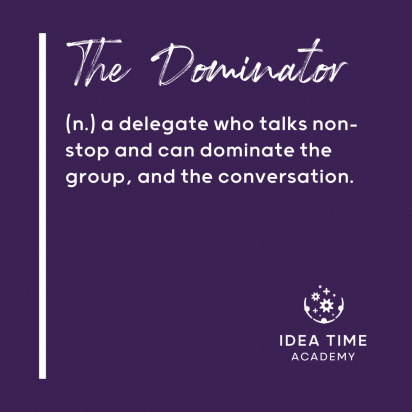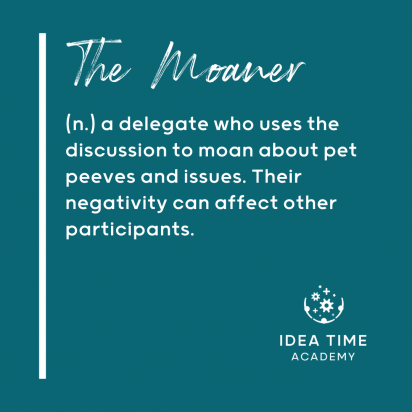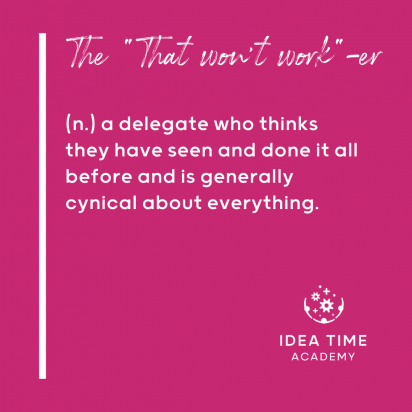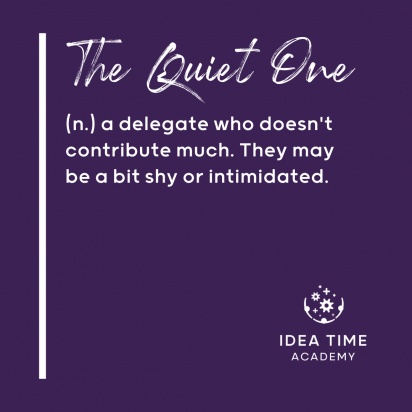Posted in Blog, Design Thinking, Influencing people, Lead by Jo North
This article is a ‘cheat sheet’ of tips and advice on how to facilitate difficult delegates. I’ve shared 4 of the 8 most common difficult delegate behaviours.
Download your free pdf ‘cheat sheet’ of the full 8 types here.
The first thing to bear in mind is that there is rarely any such thing as a truly difficult delegate, only a delegate who wants to be heard and understood – in the majority of cases, anyway! Remember that other people think that we ourselves are difficult sometimes too, and we rarely have a deliberate intention to be so. We just believe in what we are saying and want to get our message across.
Remembering that does help you to have more empathy when you facilitate, but of course you do need strategies to make sure that difficult delegate behaviours don’t negatively affect the rest of the group, or obstruct the group from achieving the target outcomes of the session.
Plus, if you have these tips and strategies in your back pocket, you will have a ready-made toolkit of approaches that you can use as and when you need to.
The difficult behaviour types I’m going to cover here are the ones that we tend to experience the most. They are:
- The Dominator
- The Moaner
- The ‘That Won’t Work’-er
- The Quiet One
To find out about the other most common difficult delegate behaviours, download my free pdf ‘cheat sheet’ that includes the 4 types covered in this article, plus the following 4:
- The Joker
- The Murmerers
- The Distractor
- The Intimidator
Here are the distinguishing characteristics of each one, along with a quick tip on how to deal with them in your facilitation session.
The Dominator
Definition
The Dominator is a delegate who talks non-stop and can dominate the group and the conversation. They disrupt your agenda and timing plan and can get in the way of contributions from other participants.

Facilitation Strategy
Create an opening to get into the conversation and intervene.
Redirect the conversation to the rest of the participants by thanking the delegate for their contribution, and then immediately asking the others in the group for their thoughts. For example, “Thank you for that, Fred. Does anyone else have any suggestions or views about this?”
Writing down the key points that the dominant delegate has made on a flip chart where they can be seen can also work sometimes. This is because the delegate then feels that their perspective has been taken into consideration.
If the delegate is persistently dominating the conversation, ask them to help you with a task that they will need to focus on to re-direct their energy.
If the behaviour is significantly disruptive, think about speaking to the person privately in a break, explaining that you really do value and appreciate their contribution but would like their help and support in getting others to contribute too.
The Moaner
Definition
The Moaner is a delegate who uses the discussion to moan about pet peeves and issues. Their negativity can affect other participants.

Facilitation Strategy
Don’t get drawn into this delegate’s pet peeves. There are a few possible strategies you can use. These include:
- Letting the delegate say what they need to say, but just once, and then moving on.
- Asking them what they would do about their pet peeves, if it were up to them. be careful with this one though, especially if the pet peeve is a bit off-topic, as it can unnecessarily extend the moaning.
- Commit to having a further conversation about the issue, outside the meeting when you will have more time to talk about it.
The “That Won’t Work”-er
Definition
The “That Won’t Work”-er is a delegate who thinks they have seen and done it all before and is generally cynical about everything.

Facilitation Strategy
Use this 3-step process to elicit a more positive response.
Step One: Ask the person if the idea would be worth doing if we knew for sure it was going to work.
Step Two: Ask the delegate to hang fire on any final or definite thoughts until the end of the discussion.
Step Three: Make sure that the discussion ends with a positive outcome with an action plan if the rest of the group still considers the idea to be worth doing.
The Quiet One
Definition
The Quiet One is a delegate who doesn’t contribute much. They may – or may not – be a bit shy or intimidated, or disengaged from the session.

Facilitation Strategy
Bring this delegate into the conversation in a considerate way. Avoid surprising them, or putting them on the spot, especially if you suspect they may be a bit shy or not feeling very self-confident. When you ask them a question, in the beginning make sure that it’s one that they will easily be able to respond to.
Show a positive response to all their contributions, and make sure that your facilitation design includes small breakout groups, pairs work and time for individual contributions through media such as sticky notes so that the person can add their ideas and thoughts in different ways.
See the other 4 most common, difficult delegate behaviour types
If you’ve found this short article helpful and would also like to learn about how to facilitate the Joker, the Murmerers, the Distractor and the Intimidator, just CLICK HERE to get your FREE CHEAT SHEET DOWNLOAD. Your free download also includes the 4 delegate behaviours you’ve read about here.
And finally…
…remember that we can never really know what is going on for people, and what they are dealing with behind the scenes. I’ve chosen to like everyone (even if I don’t like their behaviours sometimes), and to do my best to make sure that everyone feels valued, heard, respected and leaves my events with their self-esteem and dignity in at least as good a place, hopefully better if I can manage it, when they leave the workshop than when they came in.
I hope these facilitation strategies and tips help you. If you’d like to expand your creativity, confidence and impact as a facilitator, have a look at my Idea Time Academy for trainings, toolkits and resources designed to save you time and support you in your continuing professional development.

